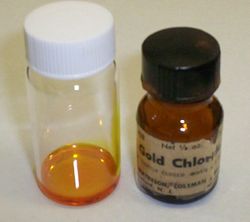Contents
- Structure
- Properties
- Preparation
- Reactions
- Decomposition
- Other reactions
- Applications
- Organic synthesis
- Gold nanoparticles
- Photography
- Natural occurrence
- References
- External links
 | |
 Ball-and-stick model of AuCl3 | |
 Crystal structure of AuCl3 | |
| Names | |
|---|---|
| IUPAC name Gold(III) trichloride | |
| Other names Auric chloride Gold trichloride | |
| Identifiers | |
3D model (JSmol) | |
| ChEBI | |
| ChemSpider | |
| ECHA InfoCard | 100.033.280 |
PubChem CID | |
| RTECS number |
|
| UNII | |
CompTox Dashboard (EPA) | |
| |
| |
| Properties | |
| AuCl3 (exists as Au2Cl6) | |
| Molar mass | 606.6511 g/mol |
| Appearance | Red crystals (anhydrous); golden, yellow crystals (monohydrate) [1] |
| Density | 4.7 g/cm3 |
| Melting point | 160 °C (320 °F; 433 K) (decomposes) |
| 68 g/100 ml (20 °C) | |
| Solubility | soluble in ether and ethanol, slightly soluble in liquid ammonia, insoluble in benzene |
| −112·10−6 cm3/mol | |
| Structure | |
| monoclinic | |
| P21/C | |
a = 6.57 Å, b = 11.04 Å, c = 6.44 Å | |
| Square planar | |
| Thermochemistry | |
Std enthalpy of formation (ΔfH⦵298) | −117.6 kJ/mol [3] |
| Hazards [4] | |
| Occupational safety and health (OHS/OSH): | |
Main hazards | Irritant |
| GHS labelling: | |
 | |
| Warning | |
| H315, H319, H335 | |
| P261, P264, P271, P280, P302+P352, P305+P351+P338 | |
| Related compounds | |
Other anions | Gold(III) fluoride Gold(III) bromide |
Other cations | Gold(I) chloride Silver(I) chloride Platinum(II) chloride Mercury(II) chloride |
| Supplementary data page | |
| Gold(III) chloride (data page) | |
Except where otherwise noted, data are given for materials in their standard state (at 25 °C [77 °F], 100 kPa). | |
Gold(III) chloride, traditionally called auric chloride, is an inorganic compound of gold and chlorine with the molecular formula Au2 Cl 6. The "III" in the name indicates that the gold has an oxidation state of +3, typical for many gold compounds. It has two forms, the monohydrate (AuCl3·H2O) and the anhydrous form, which are both hygroscopic and light-sensitive solids. This compound is a dimer of AuCl3. This compound has a few uses, such as an oxidizing agent and for catalyzing various organic reactions.





